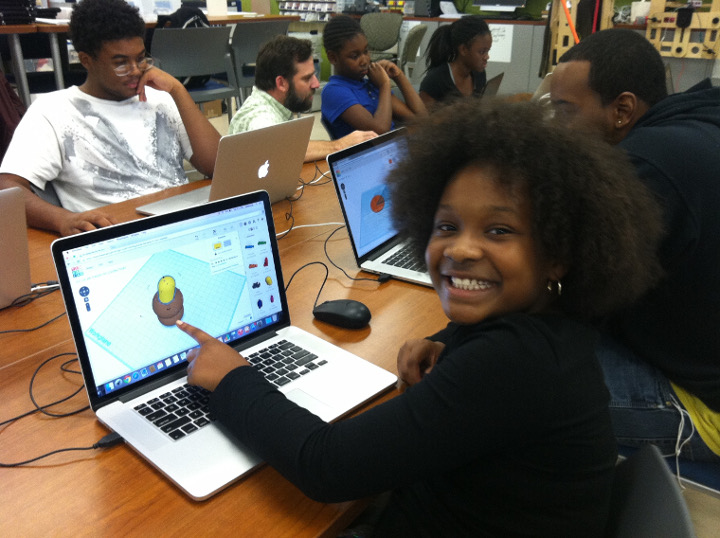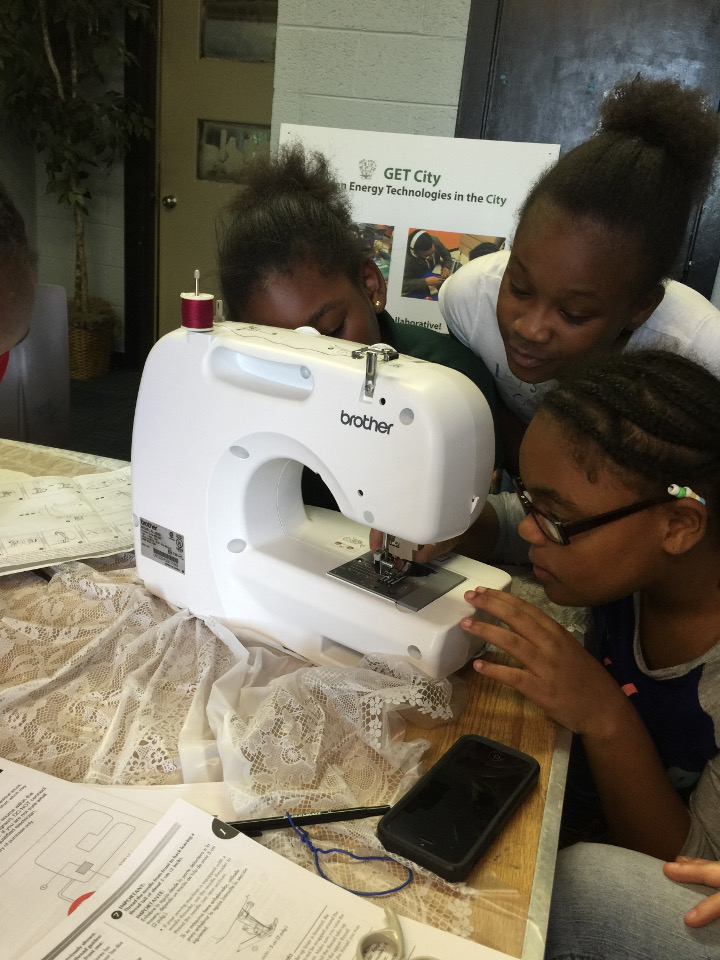Making for Change: Becoming Community Engineering Experts through Makerspaces and Youth Ethnography
This Spotlight is co-authored by Angela Calabrese Barton, Michigan State University, PI and Edna Tan, University of North Carolina at Greensboro, co-PI
I was really proud [about making my light up football] ‘cause it just made me feel good about myself so I could, like, acknowledge people what I could do. – Samuel, 12 years old
Our two-year NSF AISL pathways project (DRL 1421116) developed and tested an equity-driven approach to community-based “making space programs and pedagogies” with youth from historically marginalized communities in Lansing, MI and Greensboro, NC. The work is grounded in Research + Practice partnerships involving Michigan State University, the University of North Carolina at Greensboro, and the Boys and Girls Clubs (BGC) of Lansing and Greensboro. Project goals included:
-
To use design-based research to develop and refine an informal Science, Technology, Engineering and Math (STEM) learning program, M4C, focused on engineering for sustainable communities;
-
To develop and refine associated instructional tools and research instruments for supporting and understanding “productive identity work in engineering” in making; and
-
To study the initial impact of M4C on identity work and engagement in engineering among participating youth.

Development & Implementation
Making 4 Change reached over 60 youth makers from historically underrepresented groups in STEM with over 200 hours of programming over two years. We engaged youth iteratively and generatively in the making space activities and in community ethnography as part of an equity-driven approach to embedding local knowledge and practice into making and engineering design. In this approach, youth are positioned as partners, not mere recipients. Under the theme “Innovations for safety in communities,” youth interviewed community members (community ethnography) on pertinent safety issues they could address through making a product. Youth went through iterative cycles of community ethnography, making at the BGC club making space, and feedback sessions with community experts. Among the innovations included a rape-alarm jacket for teenage girls; a heat-up jacket for the homeless in winter; a motorized, “baby gate” for handicapped and elderly caregivers; an anti-bully app; and a small STEM library for peers at the club.
Our work yielded evidence for two core design features that support youth in sustained and robust making:
-
Structured on-going dialogues with community stakeholders, which we employed through “community ethnography as pedagogy”, and
-
Just-in-Time STEM learning activities to support the iterative deepening of STEM knowledge and practice.
Community Ethnography as Pedagogy.
As part of the making process, youth engaged in the practices of community ethnography to promote on-going dialogue with community members around the problems the youth wished to solve and their approaches to solving them through their work in a making space. The key community ethnography tools we designed with the youth included: a) data collection tools, such as interviews & surveys, and b) data analysis tools, such as Geographic Information System (GIS) mapping. Over the two years of our study, youth conducted interviews with BGC peers and staff members, university personnel (including teacher educators, graduate students, making space mentors) and family/community members in their residential neighborhoods. They designed online surveys to solicit feedback from a wide range of community members. They layered observational, interview and survey data in GIS maps to contextualize the problems they wanted to solve.
Robust STEM-making projects require STEM knowledge & practice.
We also developed “Just-in Time” (JiT) STEM learning experiences. These are short emergent experiences meant to teach critical content & practices in-the-moment that youth (and/or their making mentors) may need as they engage in more technically robust making (e.g., power requirements, energy transformations, types of circuits, 3D sketching, etc.). Making spaces will only further increase the divide between those with and without access to high quality opportunities to engage with STEM if they do not attend to foundational knowledge that supports deepening STEM knowledge and practice. For example, when 11 year-old Tamzin was prototyping a solar-powered, LED “cautious cap,” we engaged her in JiT that explored the differences between parallel and series circuits in powering more than one LED light bulb with a limited amount of electrical energy. As a result she sewed her circuits in parallel to support the outputs she desired for her hat.

Communication: Some findings
We leveraged an external advisory panel which provided formative feedback, prompting us to clearly articulate the tools associated with the two design approaches. Our research+practice approach also meant that we could respond nimbly with appropriate programmatic changes based on the youths’ feedback and emerging making trajectories. It also meant we could examine our design features in-depth using both research and practice lenses. We describe some initial findings related to the design feature of community ethnography (and its impact on youth) below, through both research and practice lenses. Youths’ names have been replaced with initials.
-
Youth were consistently engaged when they were making STEM-robust artifacts in support of their communities (as opposed to hobbyist making).
-
The problems the youth hoped to solve through making reflected both personal and community concerns that were deeply linked to their community’s unique history and context. These problems included “keeping my peers and younger children safe when playing football outdoors in our community” and “helping kids make friends” (S’s light-up football), “helping people stay safe in the dark and rain” (A’s light-up umbrella).
-
Additionally, as youth moved their projects across spaces through ethnography, they expanded the scales of criticality* and connectivity in their work by engaging with the ideas of others. They identified problems linked to broader, sustained problems that their community members (including themselves) had struggled with over time. The problems were entangled in systemic oppression, such as decaying infrastructure (e.g., limited street lighting), police brutality (e.g., need for protection), economic concerns (e.g., the high number of homeless people and poor families), and youth concerns (e.g., fostering positive peer relationships/friendships, bullying, glamour).
-
Lastly, the tools of ethnography, including interviews, observation, and open-ended surveys, opened new modes of interaction among adults and youth makers, allowing for greater movement of ideas and resources, and expanded social networks. For example, J & K created the “Warm Those Bodies!” Heated Seat & Bus Stop System, because their mom drives the #7 bus in their city. They saw their project as belonging to the whole community, not just the people who currently ride the bus. As J explained: “There are 53 seats on every standard [local] bus. . . Not only that, but several people who do not currently ride the bus told us that they would be interested in riding the bus if they knew that the bus came equipped with heated seats. We know this from a survey that we took around our neighborhoods.”

Conclusions
Who can make and who cannot, whose knowledge matters and whose does not, are all a part of making itself. Everyday decisions in makerspaces inscribe not only what counts as authentic “making,” but also youth identities as makers, participants, collaborators, community-members, young people who legitimately belong in this making space, and signifiers that endure as historicizing elements shaping the emerging culture of the youth makerspace. We argue that youth making anchored in community ethnography is a productive way to honor youths’ histories while fostering their agency to determine how and where their emerging histories, reified by in-the-moment experiences through community ethnography, can be sought for in more just ways. Given the immense momentum the maker movement is currently enjoying in the STEM fields, this is a crucial and opportune time for the youths’ voices to be included through participatory methodologies if we are collectively committed to creating an equitably consequential maker culture.
*By "scales of criticality" we mean the following: 1) criticality in terms of both "necessity" as well as "injustice rooted in power differentials"; & 2) the relationship between criticalities experienced in youths' everyday lives, such as how a youths' creation of a green-energy powered light-up football addresses different criticalities in his low-income neighborhood --lack of streetlight, playground infrastructure, youth gang activity --but also related to larger societal struggles mired in injustice -- neglect of low income neighborhoods' infrastructure, Black lives matter, stereotype of African American male youth.
Calabrese Barton, A. Tan, E., & Greenberg, D. (2017). The Makerspace Movement: Sites of Possibilities for Equitable Opportunities to Engage Underrepresented Youth in STEM. Teachers College Record, 119(7). http://www.informalscience.org/makerspace-movement-sites-possibilities-equitable-opportunities-engage-underrepresented-youth-stem
Tan, E., Calabrese Barton, A., Shin, M., & Turner, C. (2016). Probing participatory partnerships : Equitably-consequential making by, for and with marginalized youth. FabLearn '16: Proceedings of the 6th Annual Conference on Creativity and Fabrication in Education http://www.informalscience.org/probing-participatory-partnerships-equitably-consequential-making-and-marginalized-youth